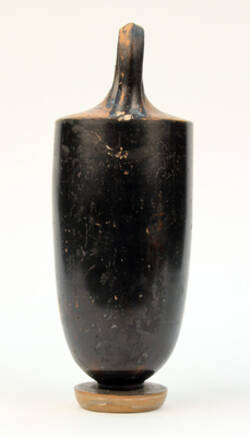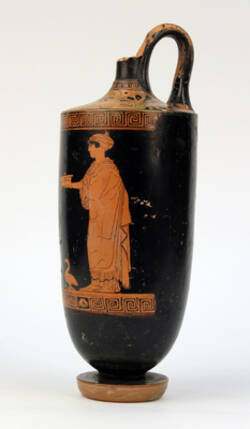With the exception of the Dresden and another red-figure lekythos, only white-ground lekythos by the Bosanquet painter, named after the British archaeologist Robert Carr Bosanquet, have survived. As far as the vessel forms and the technique as well as the predominant depictions are concerned, it can be assumed that the artist had a certain preference or specialisation in vessels for sepulchral use.
The scene from the woman's chamber also refers to a mourning picture. First of all, the hair ornaments of the seated woman, decorated with myrtle leaves, speak for the
the wine jug for libations in the background as a typical female accessory, the small box which the standing servant hands to her mistress and which is normally presented to the bride by the groom during the wedding, as well as the goose sacred to Aphrodite, the goddess of love, suggest a wedding context. But the depiction is found in this or a similar way mainly on lekythes found in graves and also on funerary reliefs. The vessels are therefore not related to marriage, but rather to death and mourning that a young woman's destiny and wish to marry did not come true.
Further Media
Today, a vase is most commonly associated with flowers. But in the early 1700s, when the scholarship of Greek vases first developed, the word also referred to every kind of ancient pottery. As a result, the term ‘vase painting’ has remained a term used by experts in the field.
To imagine the omnipresence of pottery ware in ancient times, just think of our world with no glass or plastic containers, and no metal containers on ships, trains, or trucks. Imagine all those goods being transported in pottery vessels.
Of course, simple ceramic vessels for transport were not decorated. But, apart from those vessels, there were specially shaped and painted vases, in particular for religious or ritual purposes. Written sources from antiquity have given us many terms for the different shapes of vases, though as yet scholars have not successfully ascribed these terms unequivocally to the known individual styles.
Very few surviving vases are of such outstanding quality as those on show here. Nonetheless, for research, quantity also matters! Hundreds of thousands of painted vases have been and still are meticulously analysed and studied. In this way, we can gain detailed insights into local preferences, motifs, and technical developments – and even identify individual vase painters, either because they signed their works or have a distinctive style.
Red-figure vase painting – as it is known – which emerged in Athens around 530 BC, may well be the most significant stylistic development. Red-figure vase painting came from the ingenious idea of reversing the previous technique for black figures on a red ground. By leaving red areas unpainted, the figures took on the colour of the clay; the surrounding areas were covered with a slip which turned black when fired. The result: red figures on a black background. This new style was greeted enthusiastically, and suddenly only a few potters still continued the older tradition of black-figure vase painting. The trend to red-figure vase painting lasted several generations and is found well beyond Athens itself.
- Material & Technique
- Clay
- Museum
- Skulpturensammlung
- Dating
- c. 440 BCE
- Inventory number
- ZV 2777



